Warm greetings all! 🙏 💚
It's already the beginning of July, and since my last Seaview Garden Journal Update I've (mostly) completed three new planting beds here at The Sanctuary of The Blue Dragon, and (with all the new space) gotten many more plants in the ground, some really quite exciting! I always have so much more that I want to share than what I actually do. So much is growing so quickly now that it's sometimes challenging to keep up. I do my best, however, to give you all some (hopefully) interesting updates, broken up into somewhat smaller, digestible chunks. I hope y'all enjoy this First-Day-of-July Seaview Garden Journal Update! Let's dive right in! 🤿🌿🌱🏵️
With pretty much all the planting beds that I create, I follow a very similar methodology, adapted as needed to location-specific conditions. It's basically hügelkultur, where I add lots of organic biomass (logs, branches, leaves, chopped coconuts and coconut fronds, chopped banana leaves and stems, kitchen waste, egg shells, bones, and the like), to an area (to release nutrients over time), then I cover it well with a mix of ten-year-aged macadamia nut soil and cinder (pulverized volcanic rocks), and for the last step I cover that with a mixed-wood mulch (to hold in moisture, add organic matter, slow weed growth). So for all three of these new beds that I'm sharing here today, that's how I did it!
This first new bed already had some cassava - Manihot esculenta, and a ti - Cordyline fruticosa, growing in its future location, so I incorporated them into the bed. I planted a purple and variegated variety of bele/edible hibiscus - Abelmoschus manihot 'Aunty Lilly's Pacific Bele', a 'Shishito' pepper, a job's tears - Coix lacryma-jobi, and a small collard - Brassica oleracea (Viridis group). I also stuck a section of cane of a purple-leafed sugar cane - Saccharum officinarum (variety still unknown), in the back of the bed to grow up a bit before moving and/or propagating.
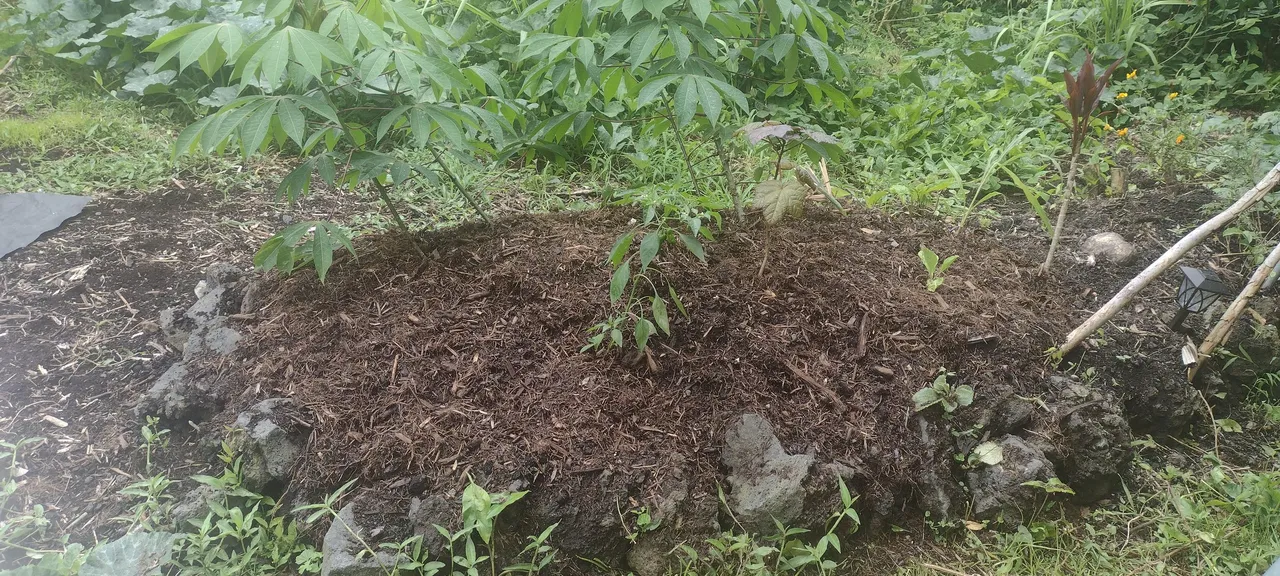
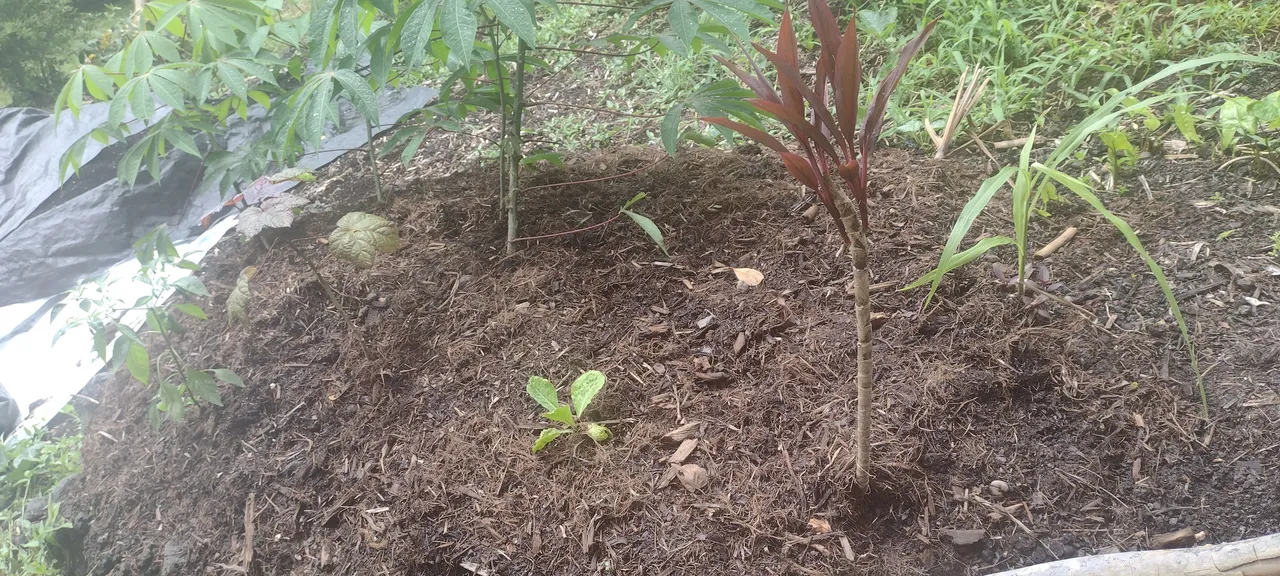
We have a trellis made of metal and strawberry guava trunks that has string beans growing on it. Sadly, we just don't make use of them all that much, and most just go to seed, so I decided to plant two species of lirikoi/passion fruit there instead. This is the first one, purple Lirikoi - Passiflora edulis.
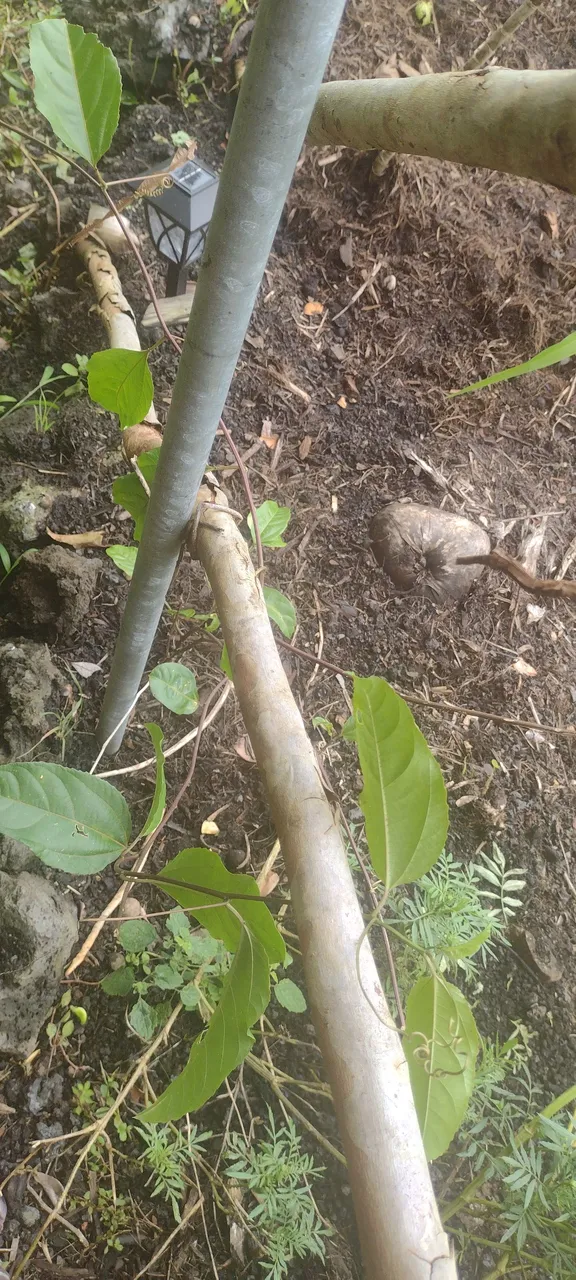
And this is the second, giant lirikoi - Passiflora quadrangularis, which has fruit the size of American footballs.
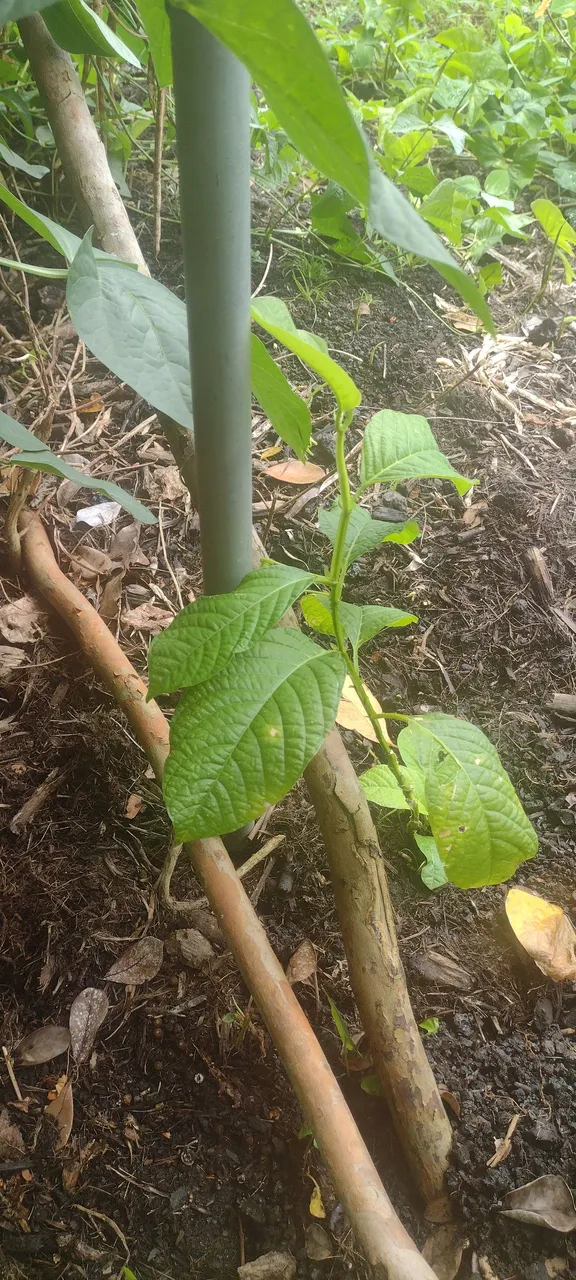
*I got a plant of Anthurium 'Princess Alexia Amor' (Andreanum Group) in the ground, to complement the white Anthurium that I had planted previously in this shade bed. This cultivar was given to my dear plant friend, Alexia. 😉😊 Anthurium do very well our here indeed. The neighbor's property nextdoor used to he an Anthurium nursery, so now, many years later, there are a great many species, varieties, and hybrids naturalized in the forest behind the property (quite a bit behind The Sanctuary of The Blue Dragon's property top), with flowers (and leaves!) of an astounding range of colors, shapes, and sizes. It's really quite amazing! I'm becoming more and more fascinated with these plants!
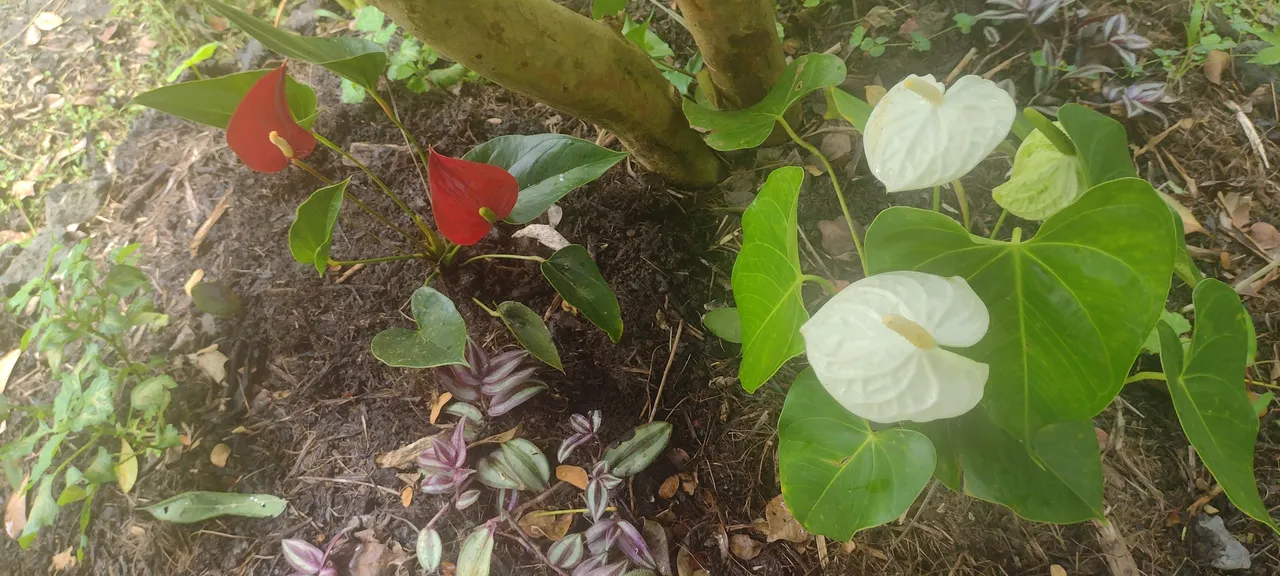
This is the second new planting bed. This took many full wheelbarrows of soil, cinder, and mulch to complete. I needed more shade and part-shade beds, so I was happy to finally finish this and the next bed. In this bed we planted Brazilian/sissoo spinach - Alternanthera sissoo, along the border, culinary ginger - Zingiber officinale, patchouli - Pogostemon cablin, turmeric - Curcuma longa, blue turmeric - Curcuma aeruginosa, Chinese rain bells - Strobilanthes Hamiltoniana, along with two unknown Impatiens varieties, to add a little color. Three large pots of cardamon - Elettaria cardamomum, that need to get in the ground, can be seen in the far left.
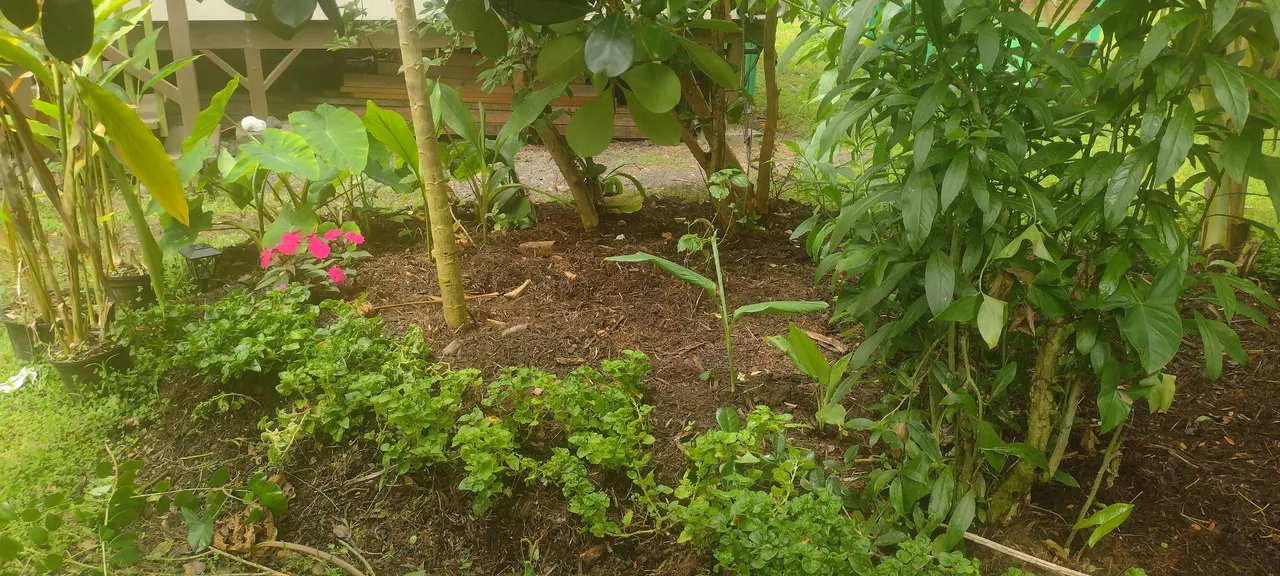

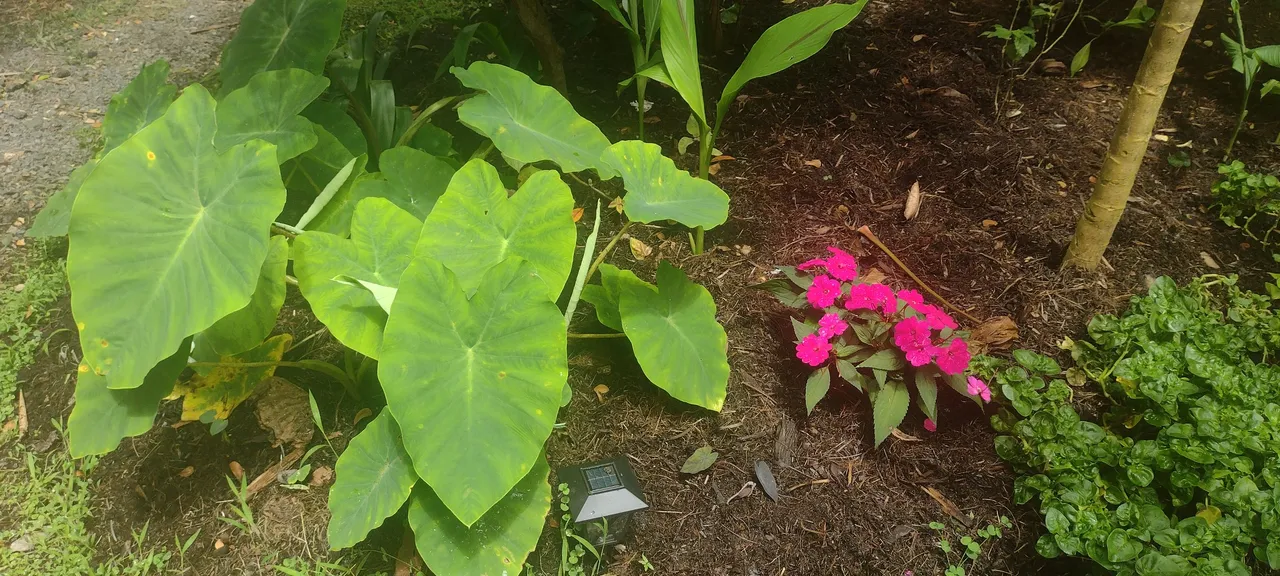
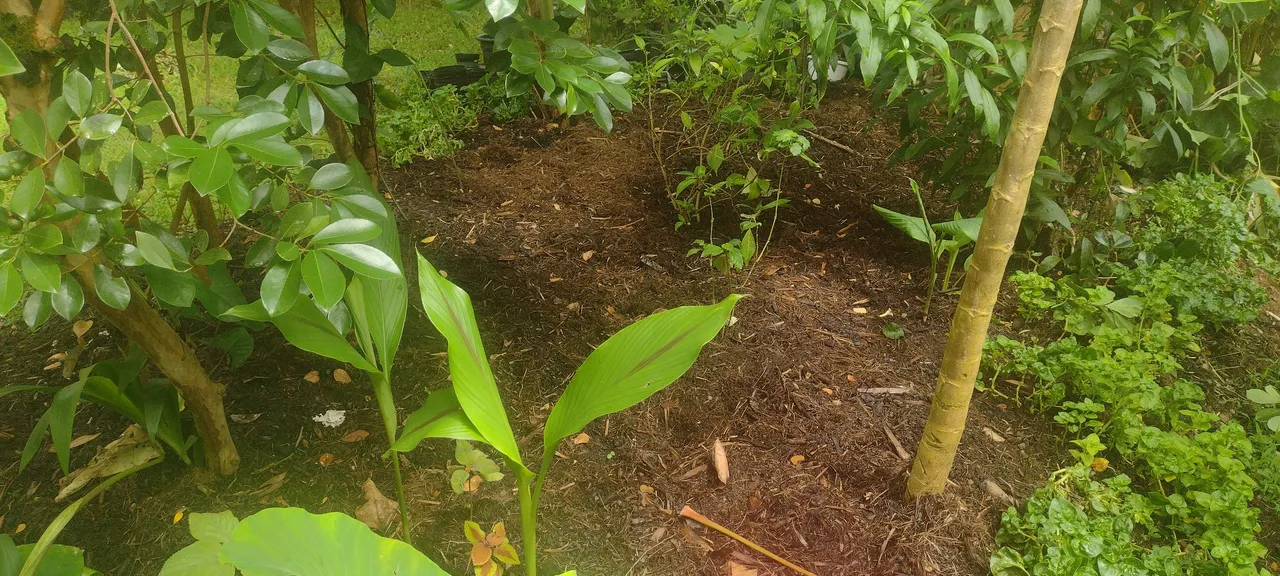
The taro - Colocasia esculenta
was already here, I just improved their planting bed and connected it to the new bed. I've also begun collecting new taro varieties. I already have a white-variegated and a purple form.
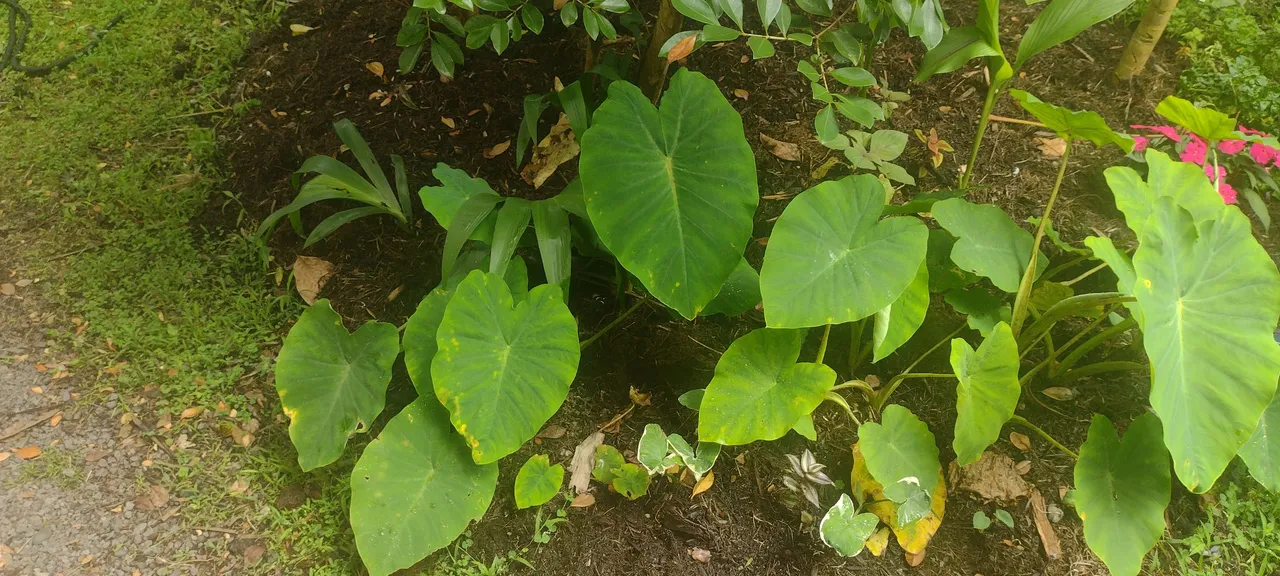
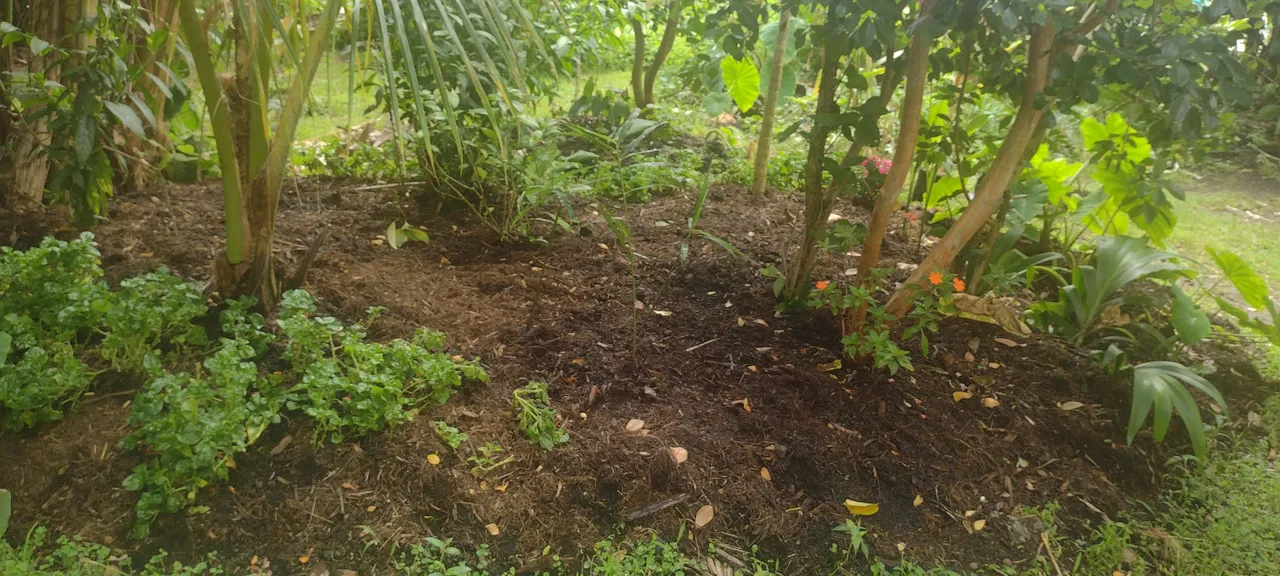
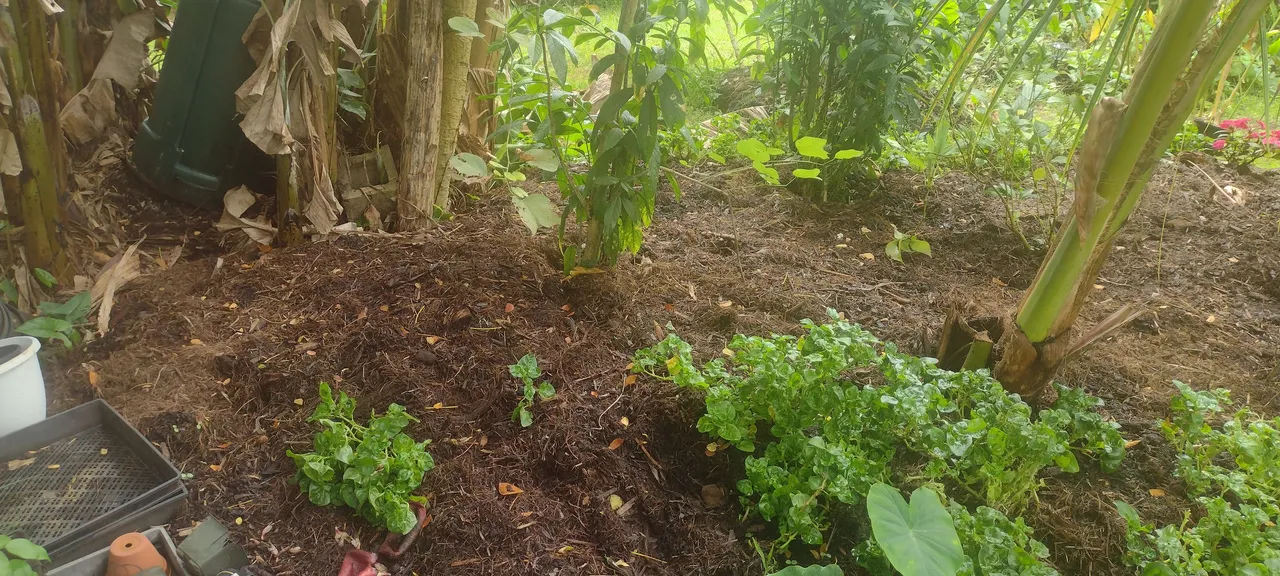
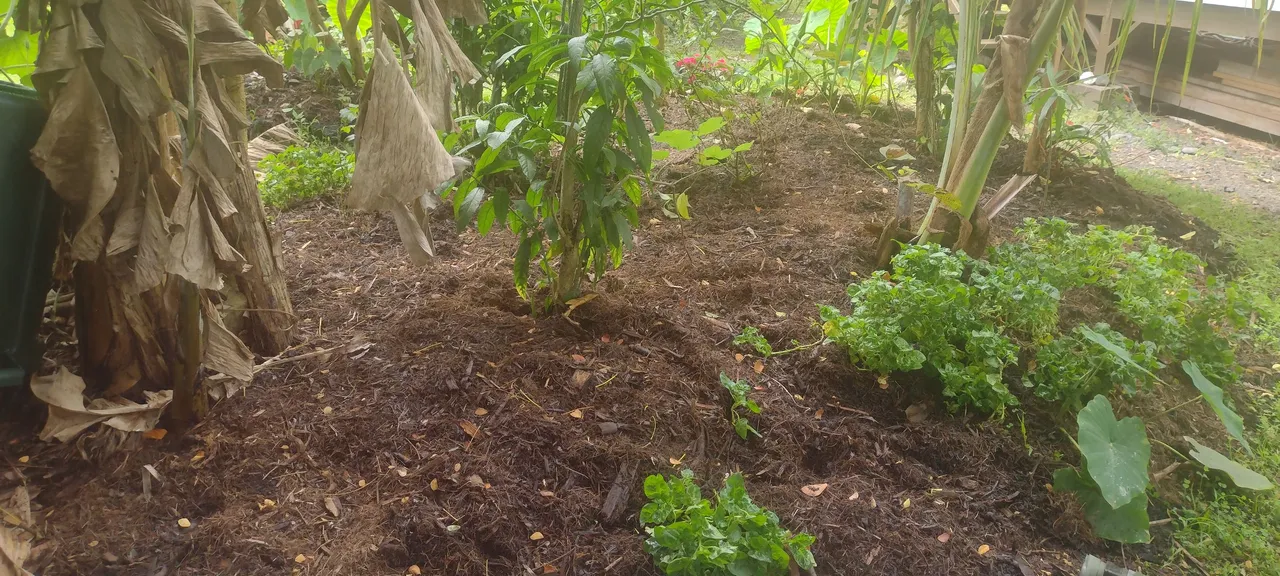
The mother plant of this orange-flowered Impatiens has been growing healthy and beautiful for over twenty years on a friend's property. I still don't know what species or variety it is, but I know I like it a lot, and it's a good, vigorous clone.

Culinary ginger - Zingiber officinale
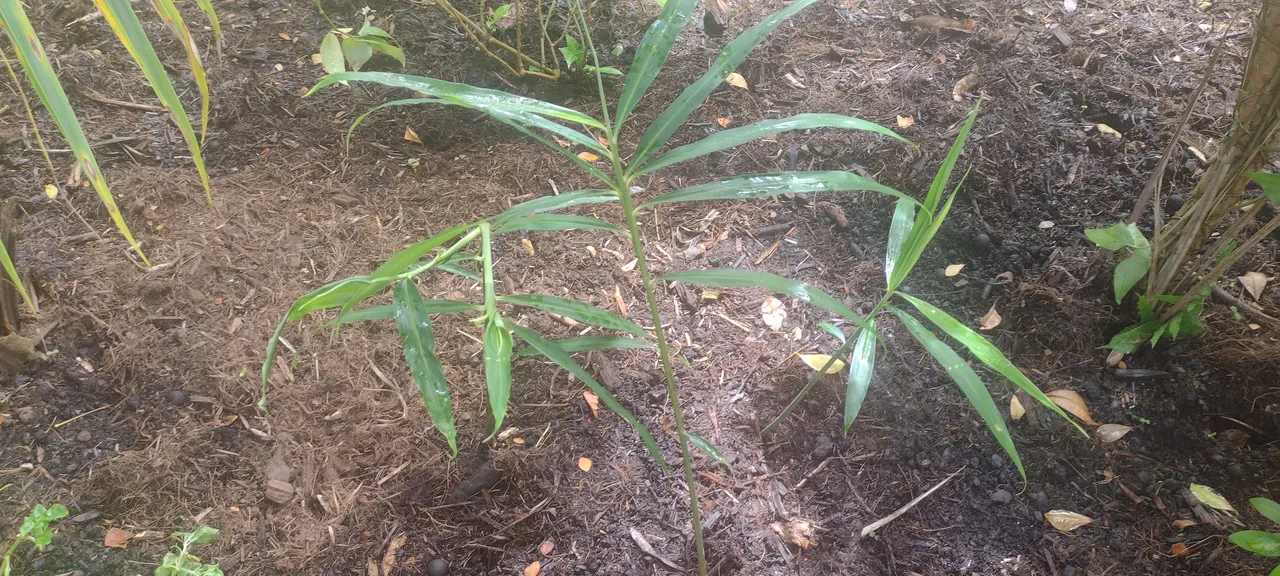
Turmeric - Curcuma longa and patchouli - Pogostemon cablin
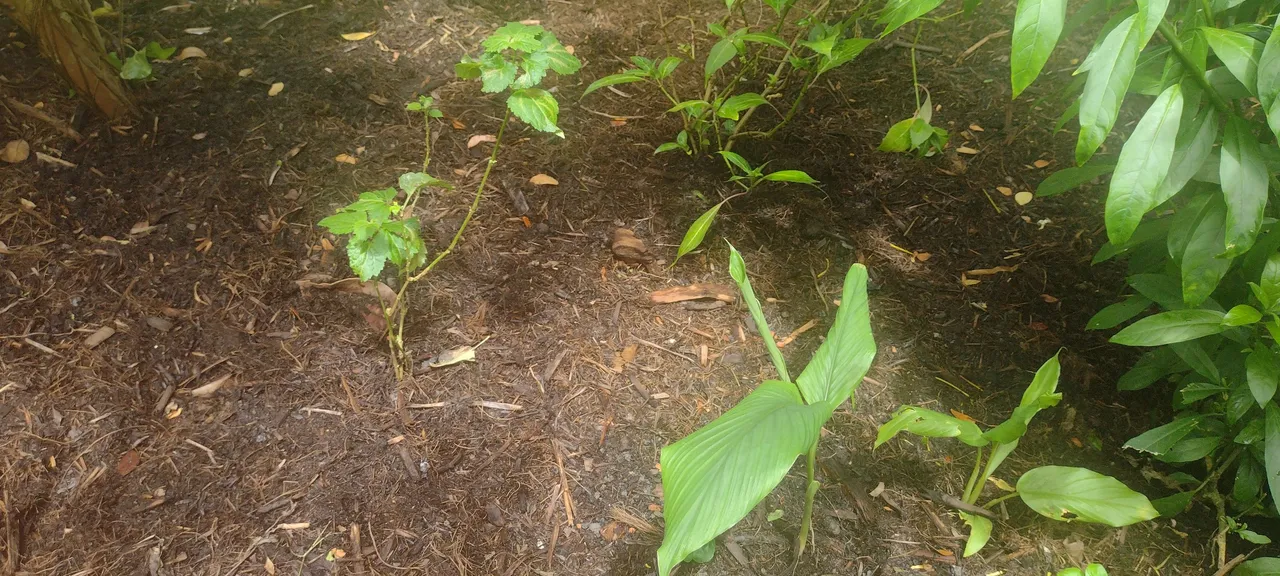
Blue turmeric - Curcuma aeruginosa

An unknown magenta-flowered New Guinea Impatiens variety that I'm testing out, next to some Brazilian spinach - Alternanthera sissoo.

Blue turmeric - Curcuma aeruginosa and taro - Colocasia esculenta
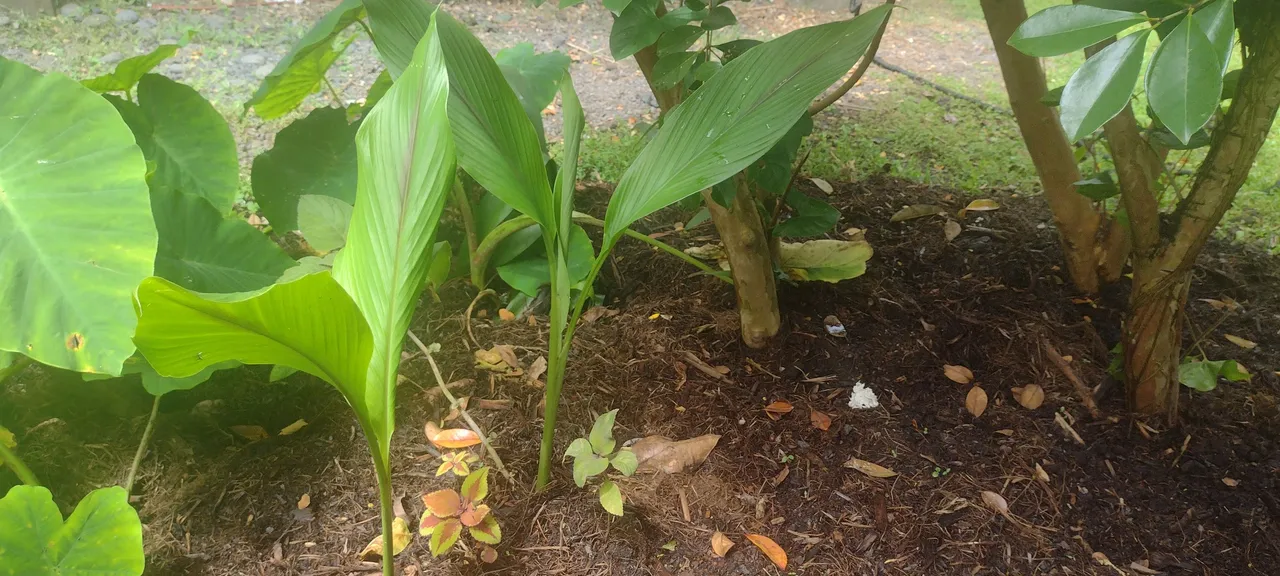
Chinese rain bells - Strobilanthes Hamiltoniana
I've come to deeply love and appreciate this plant, so I plant it everywhere. Its both beautiful and very medicinal, noted for its deworming and detoxifying effects. It's really adaptable, so if grows in most places very well indeed. It will bush up and be covered with pendant pink flowers very soon. Turmeric and patchouli can be seen off to the sides.
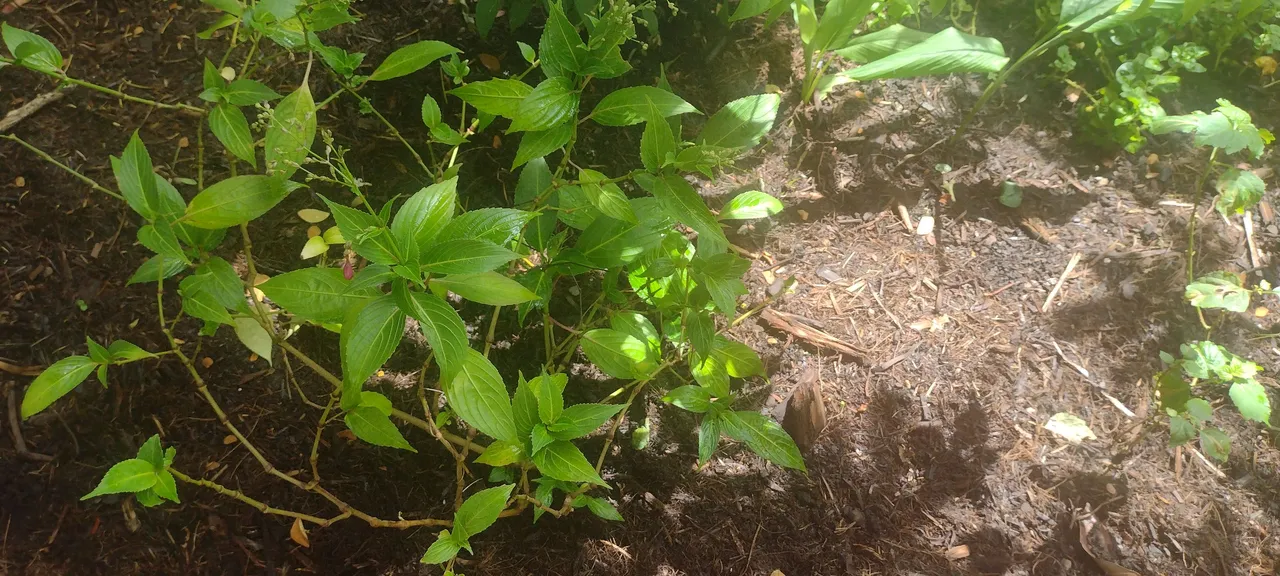
Here's the third and last new bed. It's in the shade of a monkey pod tree, Samanea saman. One of my teas - Camelia sinensis, can be sean just in front of it.
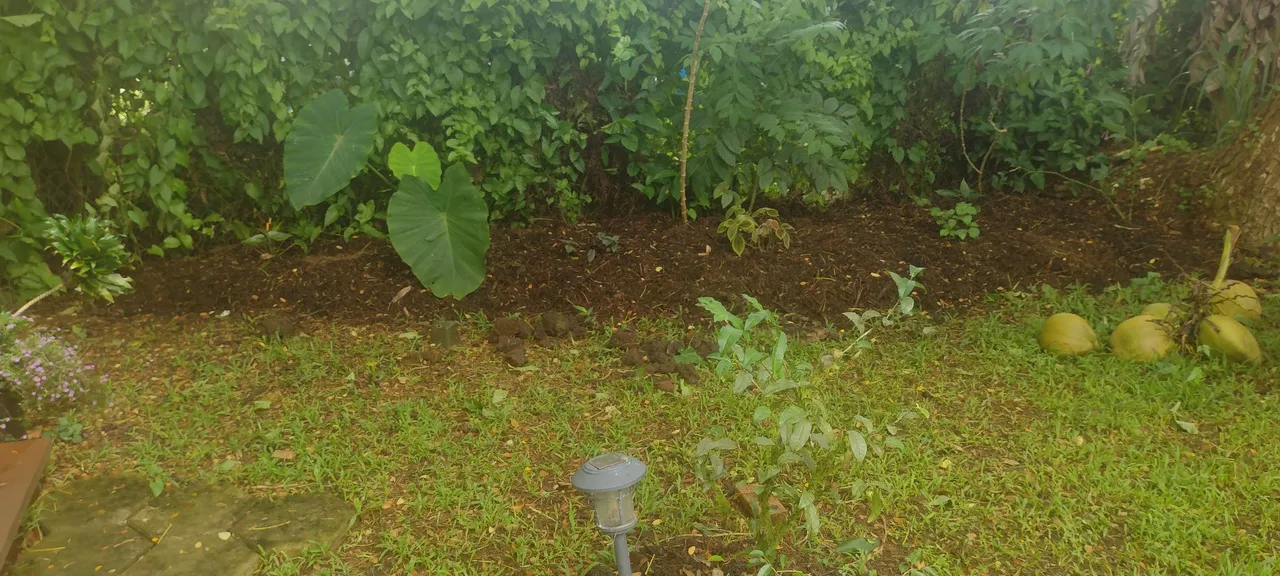
I planted another Anthurium 'Princess Alexia Amor' in this bed, next to some taro.
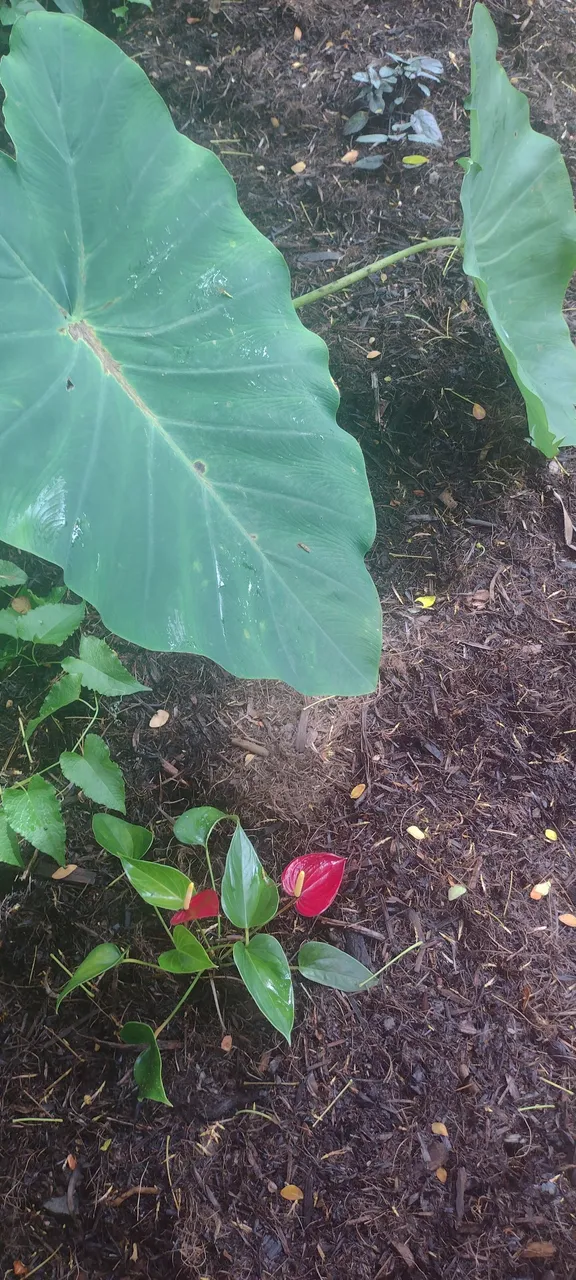
Here's a purple waffle plant - Strobilanthes alternata and a friendship plant - Pilea mollis, both of which do quite well in this kind of high shade. Both species are usually used as ornamentals, though both are very likely notably medicinal as well, as other related species are. I did find that Strobilanthes alternata is used to heal wounds in India and Ayurveda.

I put another patchouli - Pogostemon cablin
and Chinese rain bells - Strobilanthes Hamiltoniana here too, as I love and use both in my medicinal teas.

Aside from planting, I also had to transplant a couple species to better growing conditions.
I moved this jaboticaba/Brazilian grapetree - Plinia cauliflora from a non-ideal location to an a bit more shaded, protected area. They grow slowly and like a bit of shade, especially when they're young. Their delicious fruit makes them worth the wait until they mature.

I moved some dragonfruit cactus - Selenicereus (I'm not certain the species yet, as there are several) to a far better, sunnier location under an Ohia - Metrosideros polymorpha, which it will climb in time.
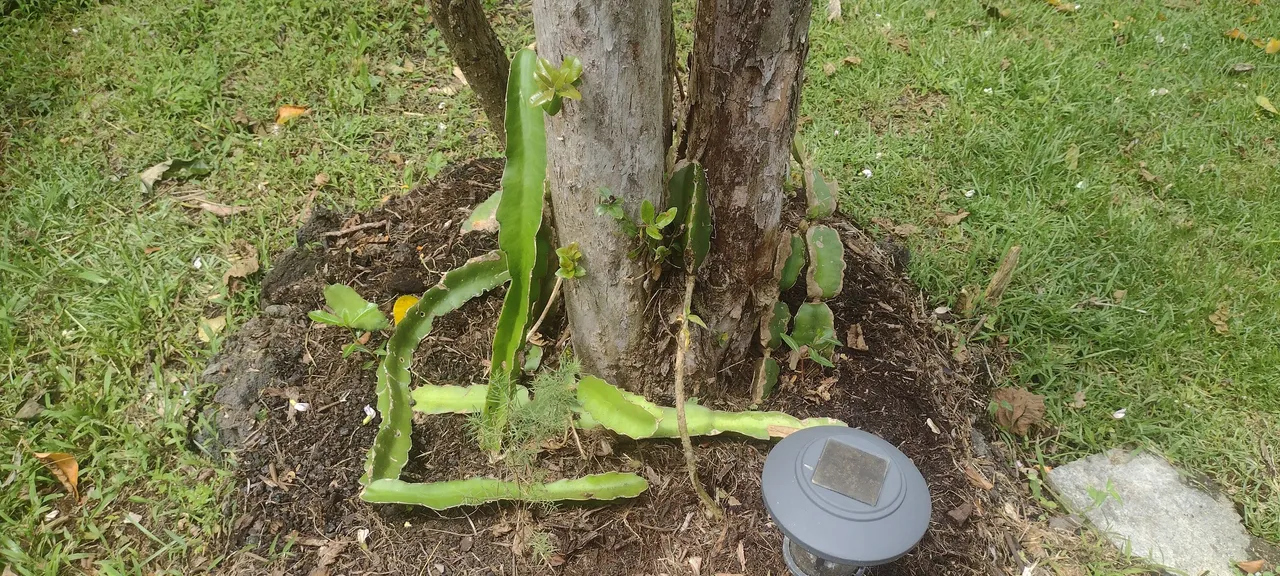
This my garden friends is a tropical, no-chill peach - Prunus persica 'Tropic Prince'! I'm super excited to get this in the ground! Peaches! In lowland Hawai'i! The Brazilian cherry - Eugenia brasiliensis, that I planted a couple months ago can be seen behind it.
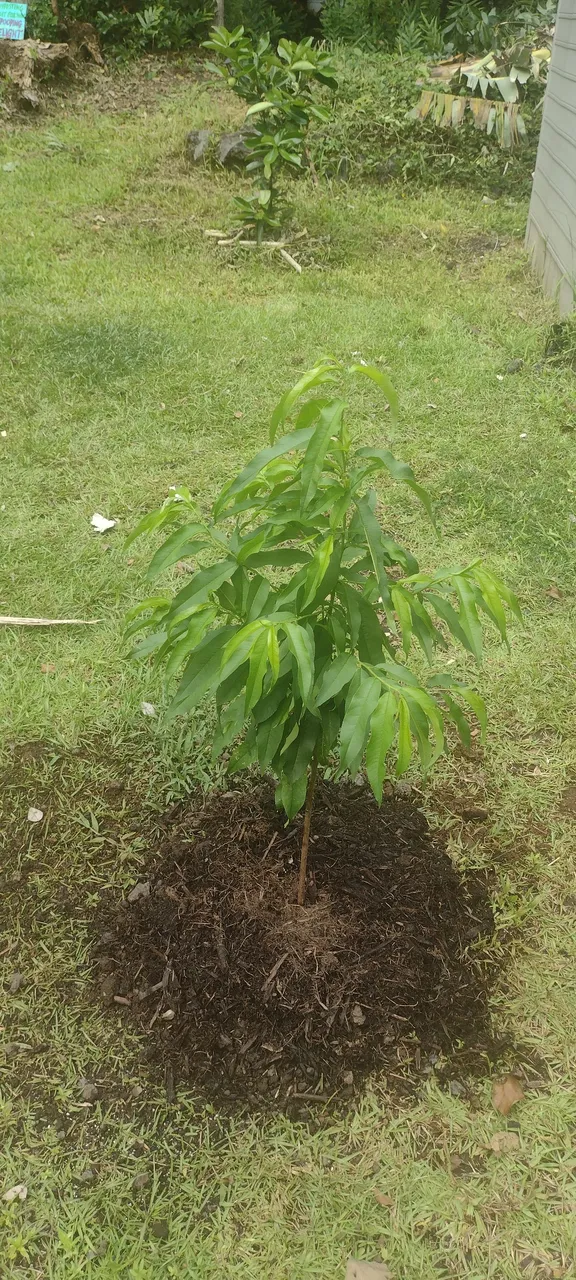
This is another exciting plant for me to get in the ground. It's an acerola cherry - Malpighia emarginata, a superfruit with 50-100 times the vitamin C compared to oranges. They grow well here, so I can't wait for fruit to eat fresh or put in smoothes, also so I can get seeds to grow! I got this acerola cherry and the tropical peach at the Kaimu/Kalapana Farmers Market last Saturday. Some sections of Moringa - Moringa oleifera, from topping our two trees, and that need to get planted, can be seen behind the acerola cherry to the left.
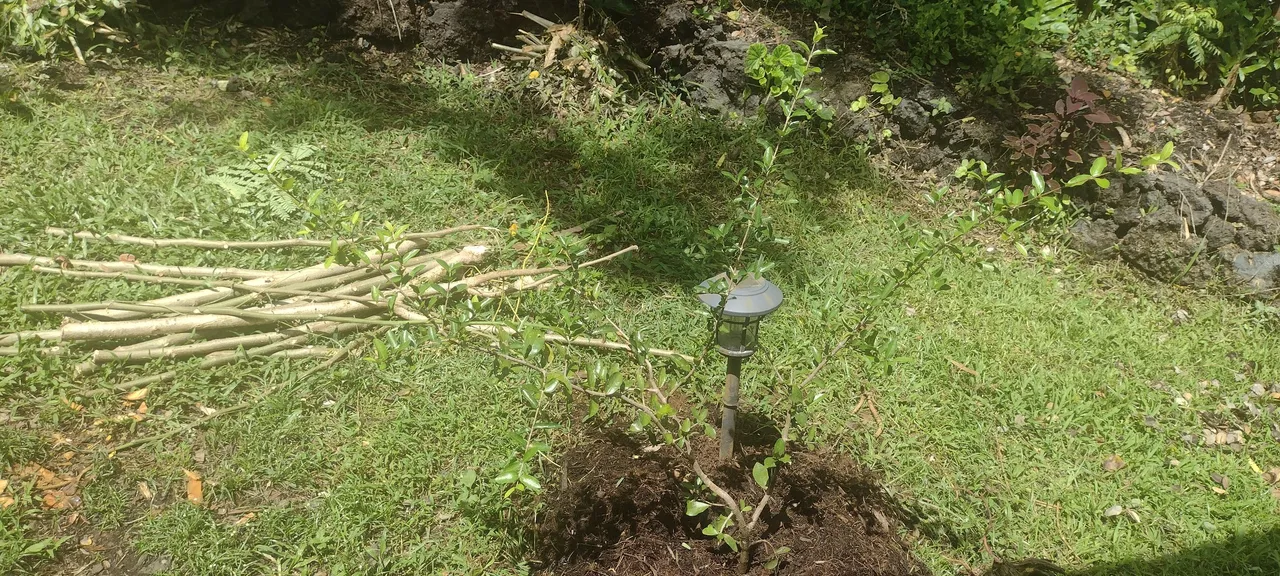
I planted a few more plants in the Noni bed, which is looking better and better! Vana tulsi - Oncimum gratissimum and mate - Ilex paraguariensis can be seen in the right-front, and a smaller ohia - Metrosideros polymorpha can be seen in the left-front.
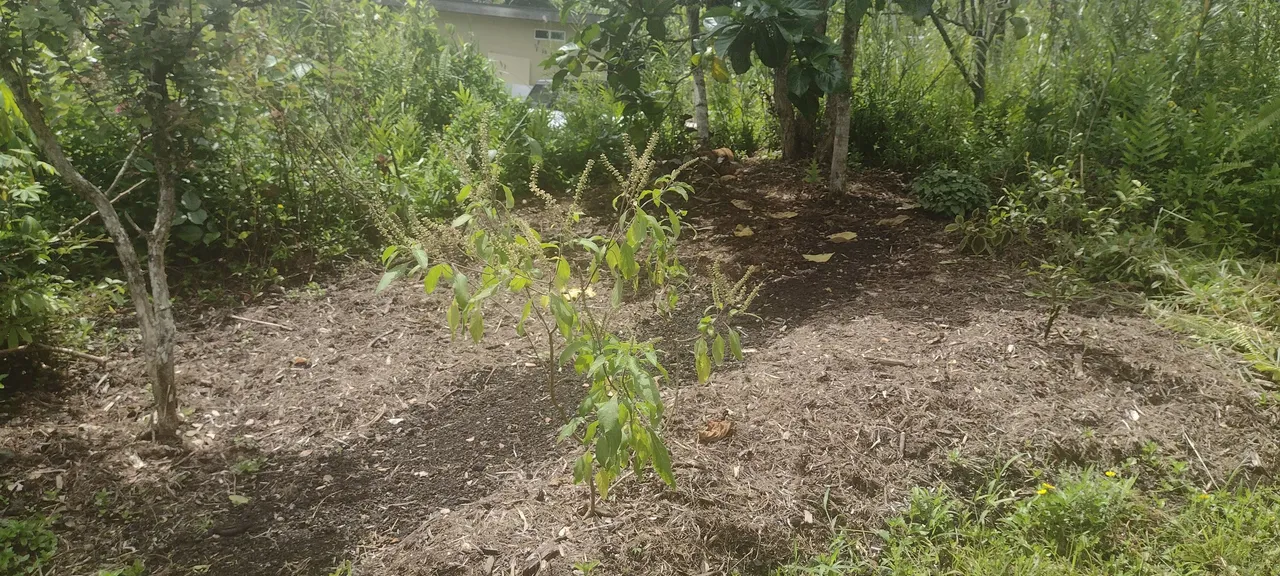
Another patchouli - Pogostemon cablin and friendship plant - Pilea mollis.
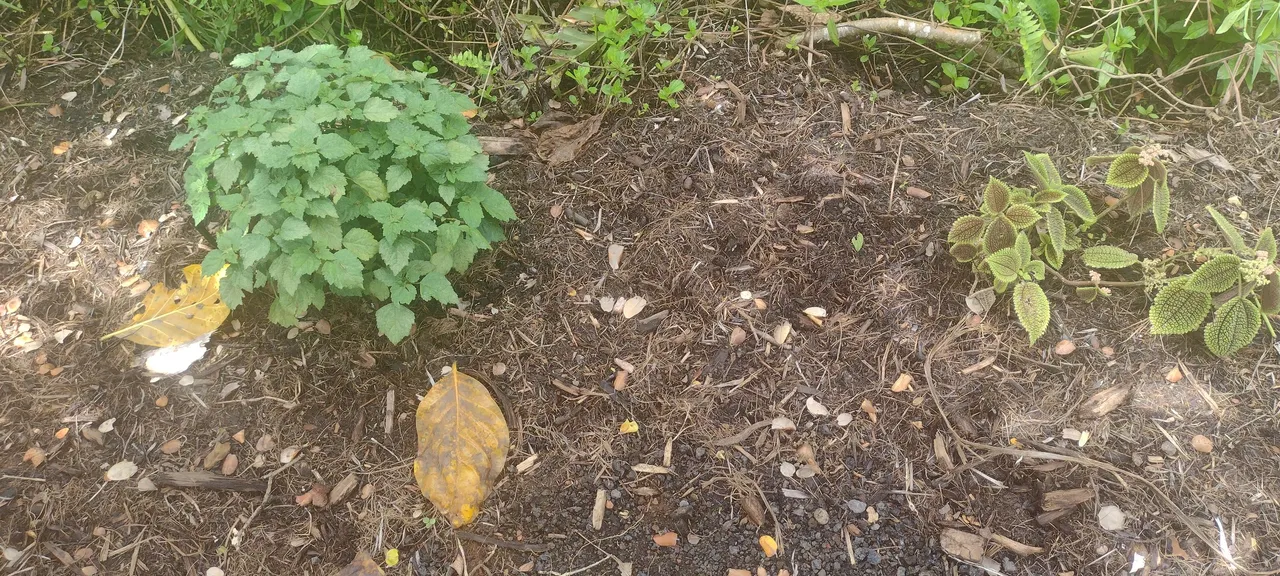
And another purple waffle plant - Strobilanthes alternata, planted right next to another Strobilanthes, the Persian shield - Strobilanthes dyeriana, planted previously. Another of my teas - Camelia sinensis, can be seen just to the left of the waffle plant. The cute orange cat posing in the photos is called Forrest.🐈
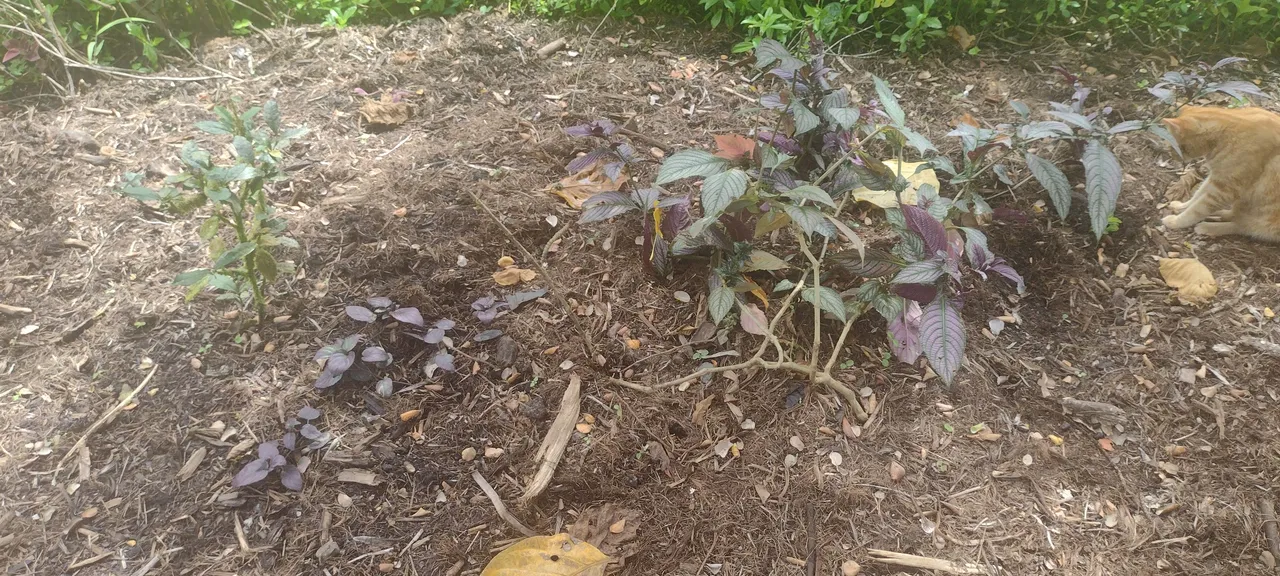
I planted another Chinese rain bells - Strobilanthes Hamiltoniana, to have all three Strobilanthes species that I have together in one place. Interesting things, like hybridization, sometimes occur when multiple members of a genus are grown together. This whole genus is quite medicinal. This plant looks a bit gangly at the moment, but it will grow and fill out quickly, and will soon be covered in gobs of lovely pink pendant flowers!
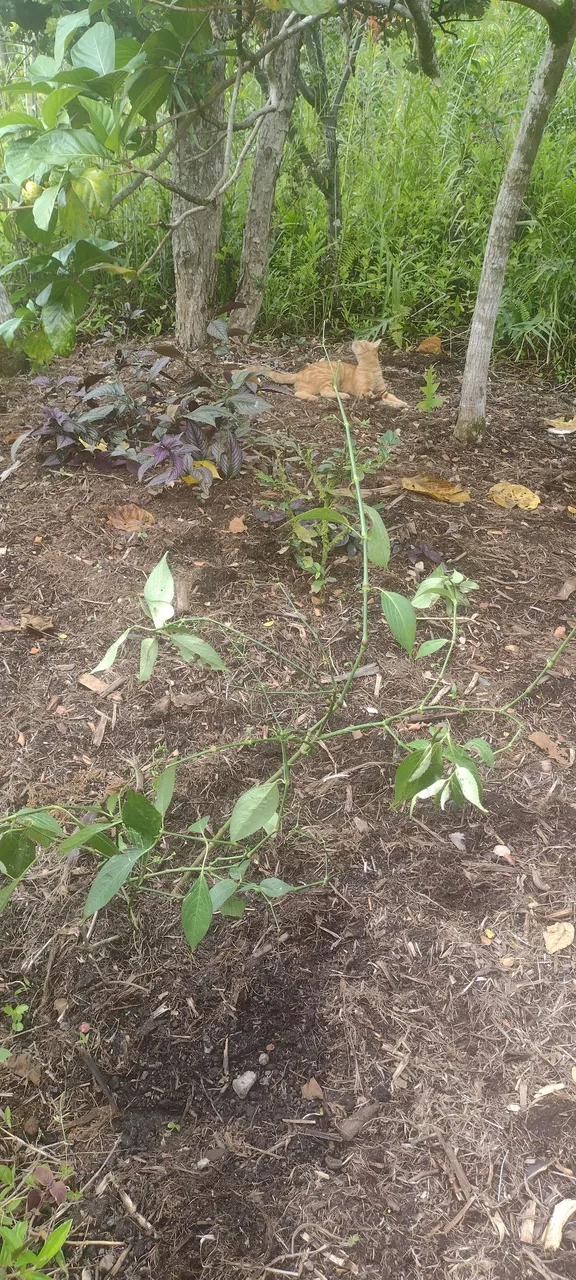
The mullein - Verbascum thapsus growing by the front steps of the community event building is going to flower, so soon we'll have a large quantity of seeds of this wonderful medicinal to sprinkle about here and there.
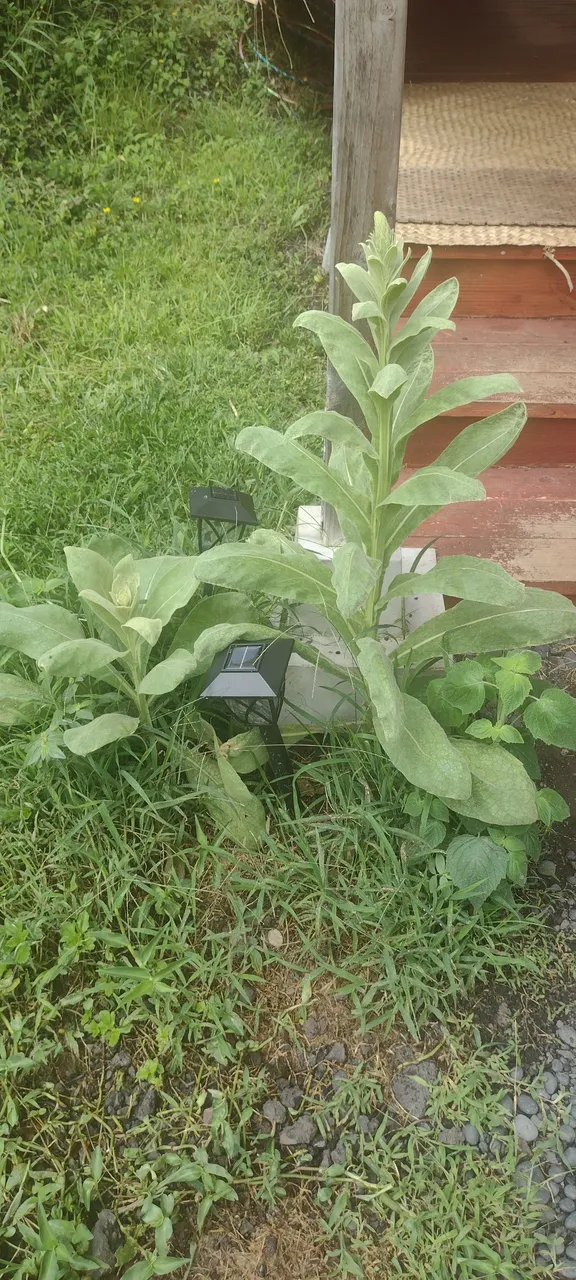
My partner, @kai-sunrise, and I made this simple tripod trellis out of thin strawberry guava trunks, then wrapped it with some very strong vines.
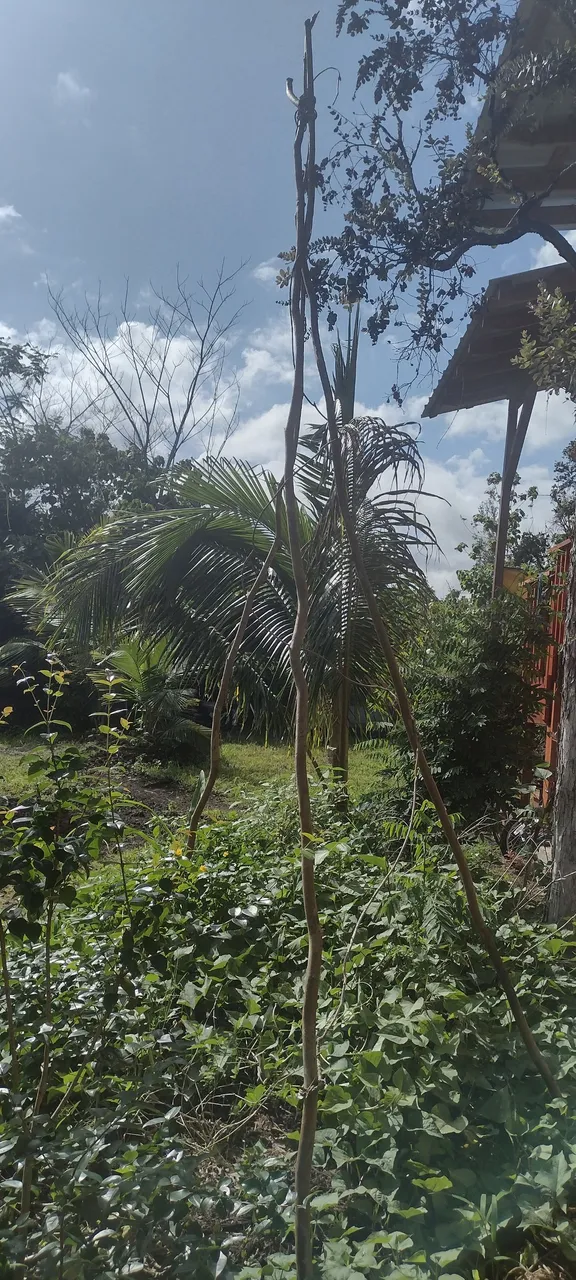
We made the trellis so that this lovely plant, Clitoria - Clitoria ternatea, has a place to climb. Yes, the genus name alludes to the resemblence of the flowers to the human clitoris and vulva. This is a newer plant to me, so I don't know it well yet, but it seems to have notable medicinal uses, which I'll explore over time. No flowers just yet, but it will be covered in them soon, of deep blue.
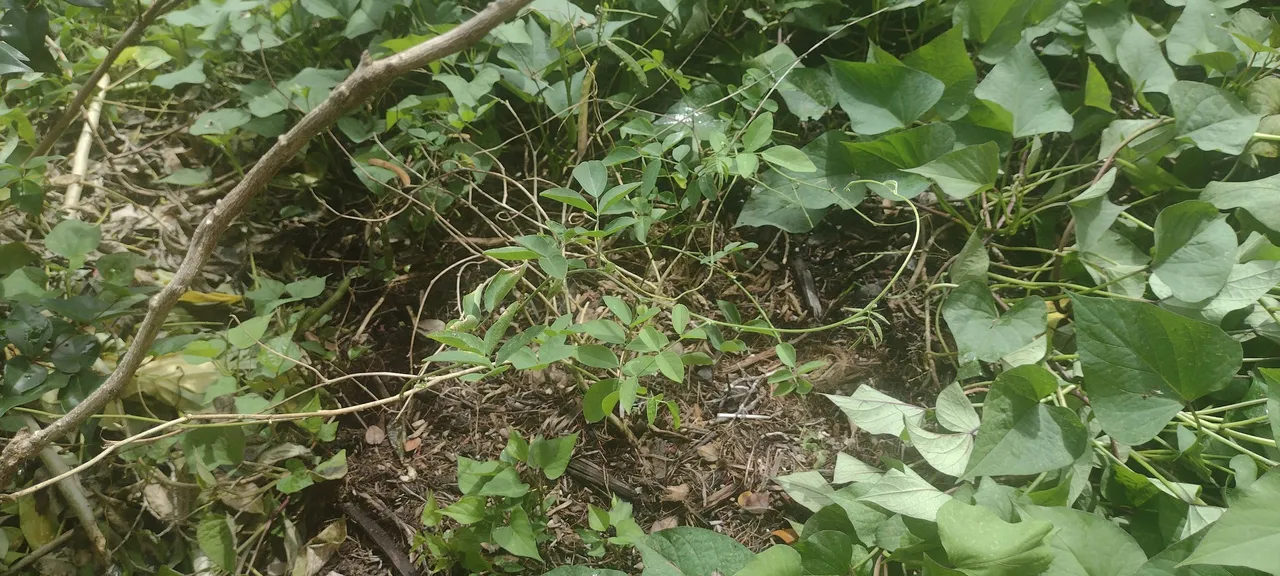
The Russian comfrey - Symphytum x uplandicum, planted with Krishna tulsi - Oncimum tenuiflorum, is beginning to flower. This sterile hybrid does not produce seed, but the flowers are a lovely purple.
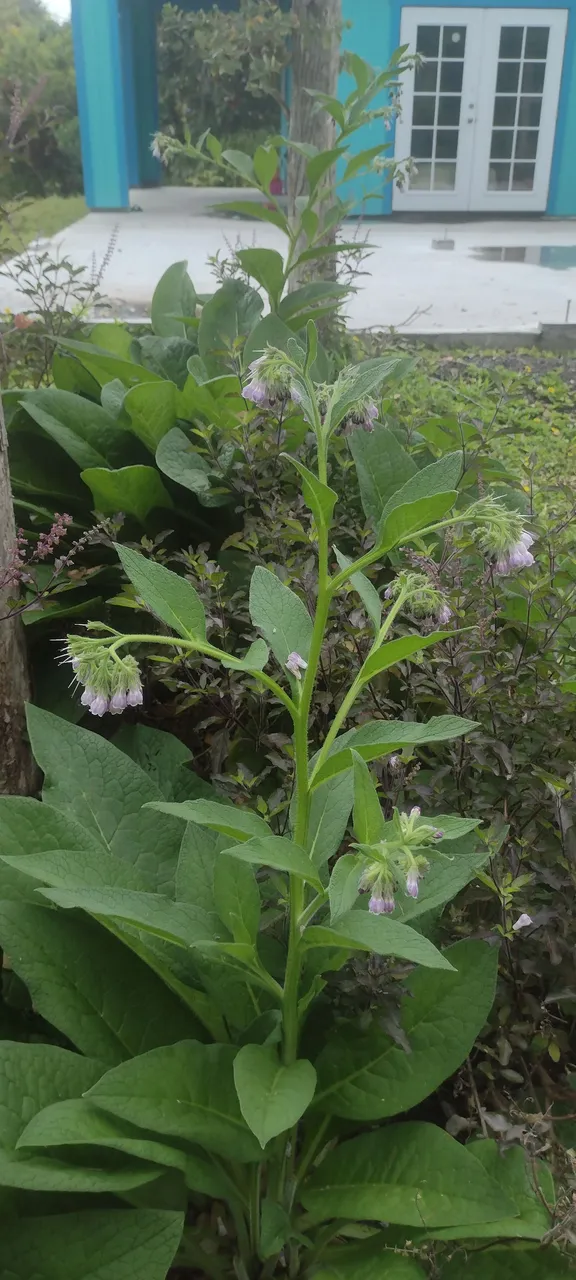

A few of the pink-flowered tobacco - Nicotiana tabacum in the herb garden have grown like gangbusters (many other plants in this garden have also grown exceedingly well also), with profuse pink flowers, to over ten feet tall! I've grown this tobacco in various situations for years, but I've never seen it get this big!
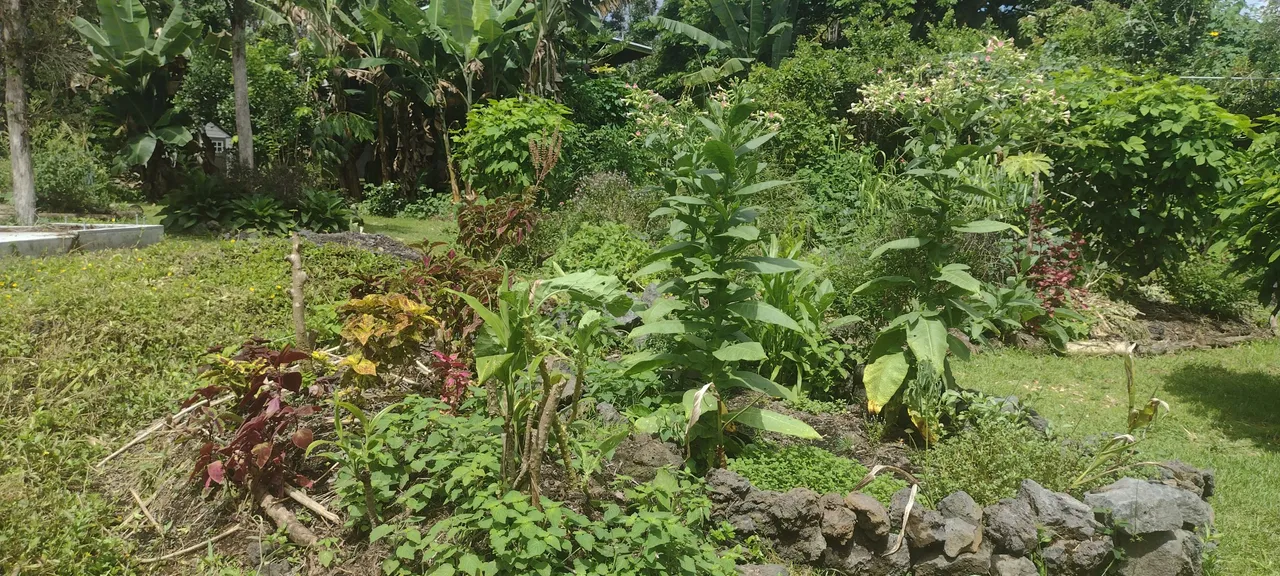
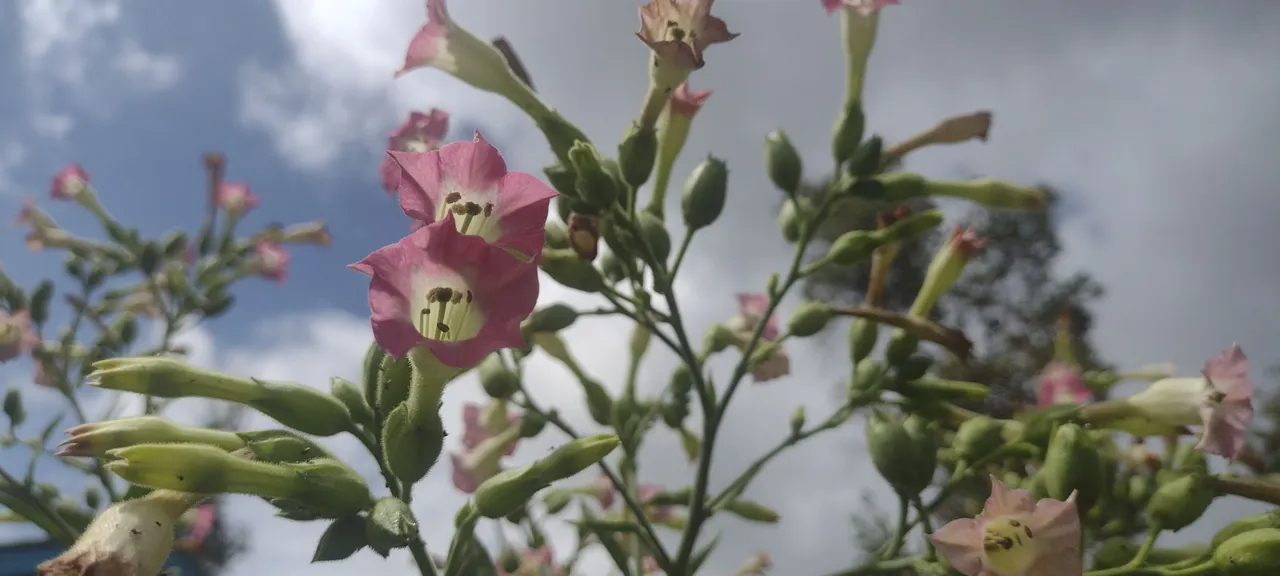
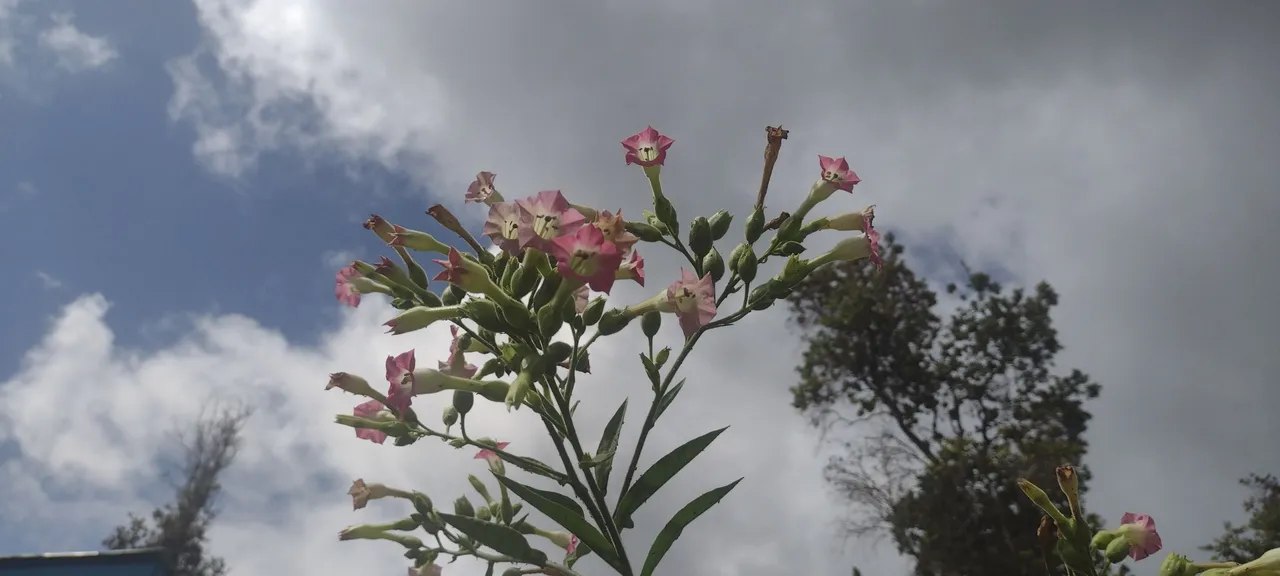
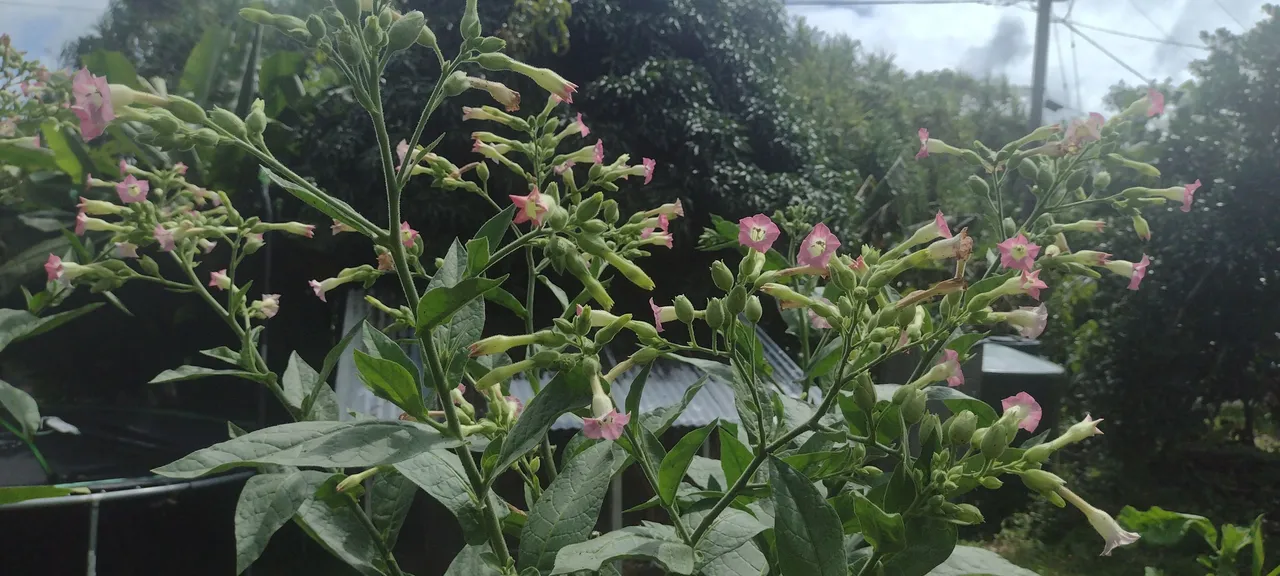
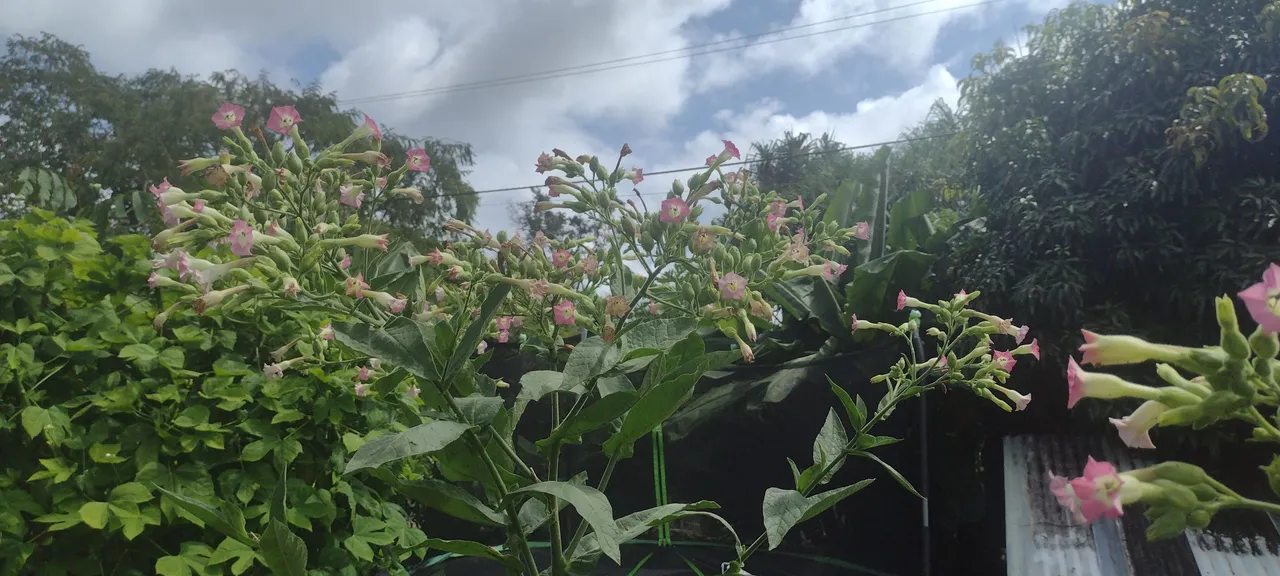
That brings us to the end of this First-Day-of-July Seaview Garden Journal Update! I hope it was an enjoyable and interesting experience! Until next time!
If you'd like to read about and be a part of the #GardenJournal Challenge, here's the link! I'm tagging my partner, @kai-sunrise, and my friend, @sundoglight!
Thank you all so much for allowing me to share more of the beauty and magic from my life and my world with you, and for your continuous appreciation and support! I am deeply grateful! 🙏 💚

Image created by @doze.